India: Land of Eternal Ink
Article © 2009 Lars Krutak
Among the Chang Nagas, the ceremonies and
tattooing patterns for men were different.
Boys who accompanied a war party, but who
returned home before actually participating
in a battle, had a little hole pierced in
the upper part of the earlobe. The men who
brought back enemy heads were permitted to
have their chest tattooed with what writers
have variously described as two "ostrich
feathers," a "V-shaped" chest marking,
"fertility fountain," or what the
Khiamniungan call "tiger chest" (Fig. 39) in
reference to the belief that they become
"tiger-like" when killing their enemy. After
additional victories, tattoos of human
figures were added as they were among the
Khiamniungan, Wancho, Lower Konyak (Fig.
40), and Burmese Naga groups. Later on the
arms, shoulders, calves, and back were
tattooed.
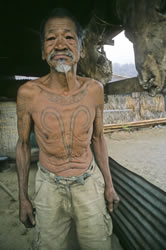 |
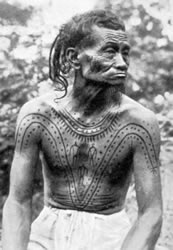 |
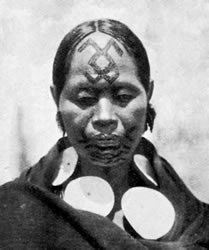 |
|
Fig. 39) Khiamniungan
"tiger chest"
Photograph © Lars Krutak 2009-2007 |
Fig. 40) Lower Konyak
man with chest tattooing, ca. 1925 |
Fig. 41) Chang woman
with facial tattooing, ca. 1925 |
Chang women were tattooed only their faces.
The most prevalent pattern is made on the
forehead near the hairline (Fig. 41). Women
of the tribe interviewed in the 1960s said
that they wore such a tattoo because it
would frighten any tigers that crossed their
path. Indeed, elders at the time could never
recall one instance of a woman being
attacked by a tiger! Of course, I
interviewed a Chang woman about her forehead
tattoo. In this particular village, the
tattoo pattern is associated with a maiden
who sacrificed her life to save the village
from a great flood brought about by a breach
of taboo. The deity responsible for the
incident promised that the water would
recede if the women of the village began
tattooing this symbol upon their faces.
Other Naga groups affirm that this common
symbol allows the ancestors to recognize the
marked woman after she has died or that it
could be used as currency to purchase food
and other provisions in the afterlife. The
non-Naga Abor of Arunachal Pradesh also have
a similar belief.
Wancho Naga women did not wear any tattoo
patterns on their faces. But they did
receive extensive tattooing all over their
bodies. Besides being a form of personal
adornment, tattoo also had social and ritual
importance. Different designs of tattooing
were placed on different parts of the body
according to a woman's social standing in
the community. For example, women from a
chiefly family may have had very elaborate
designs all over the body while others who
were lower in rank (e.g., commoners), had
much simpler tattoos. At the same a woman's
markings signified her progression through
several life stages from puberty to marriage
to pregnancy.
A girl received tattoos four times in her
life. Her first tattoos (chung hu or chungsu)
were placed over the umbilicus around the
age of six to seven years (Fig. 42). This
tattoo resembles a Maltese cross branching
out in four directions from the navel. In
the case of a chief's daughter, zigzags are
added at the ends of the radiating lines.
When a girl reached puberty, her calves and
legs were tattooed with various
configurations of horizontal, perpendicular,
and zigzagging lines. Aristocratic women
were given a series of diamond or lozenge
designs over their tibia or shins (Fig. 43).
After this second stage of tattooing had
been performed, a male suitor proposed to
her parents. He sacrifices a pig, prepares
rice-beer (zu) and sends these gifts to her
parent's house along with a basket of cooked
rice. The third stage of tattooing is done
on the thigh above the knee when the girl
leaves her parent's home to live with her
husband. In some villages, this tattoo is
given after she has conceived, and the
design consists of fine parallel lines
running up from the knee. A chief's daughter
may have eight additional small dots
arranged in two rows on the top of the
lines. The final stage of tattooing is that
which is placed on the chest in the
husband's house in the seventh month of
pregnancy or after the birth of the first
child. The design resembles an "M" in three
lines shooting upwards between the breasts.
I was told that it represents an abstract
anthropomorph (Fig. 44). Such designs, if
received by aristocratic women, have
additional lines forming the body of the
figure. Women of this class may also have
their arms, shoulders, and scapulae tattooed
with checkered designs of diamonds or
lozenges (Fig. 45).
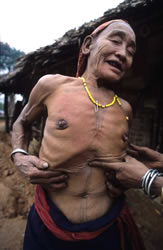 |
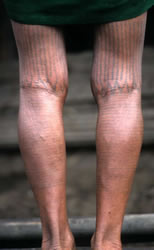 |
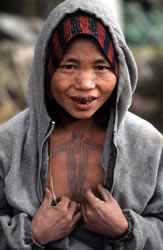 |
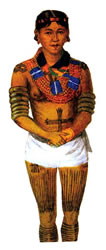 |
|
Fig. 42) Wancho elder
with
navel tattooing. |
Fig. 43) Wancho woman with elaborate leg tattooing |
Fig. 44) Sternum
tattoo of a human anthropomorph |
Fig. 45) Tattooing of
a
Wancho aristocrat, ca. 1875 |
The technique of tattooing is similar to that described above for the
Ao Naga and the instrument resembles a small adze with one row of five
to seven cane needles (siit) attached to the head of the tool. However,
only aristocratic women or "tattoo Queens" (e.g., chief's wife) could
work as the tattoo artist. Traditionally, the day for tattooing was
arranged through a divination ritual and a feast was given to mark the
occasion. Before the female tattooist performed the operation, she
observed a food restriction and only ate rice and bamboo shoots. She
also wore the leaves of a wild plant called chunian in the ear which may
have "cooled down" any spiritual activity in the immediate vicinity.
Patterns were stenciled on the body part to
be tattooed and the pigment was prepared
from soot obtained from charred wood mixed
with pine-sap resin and water. While the
skin is pricked by the female artist, or
rather lightly "hammered" with the tattooing
implement, the skin is stretched by an
assistant. The blood that oozes out is
smeared with a bluish juice made from the
charred and pulverized remains of a jungle
plant to enhance the blue-black coloration
and to heal the punctures. Payment consisted
of one leg of a sacrificed pig, one basket
of cooked rice and four bamboo tubes of zu
for the second stage of tattooing. After the
third stage, the tattoo artist (hu tu nu)
again receives these items and one metal
armlet.
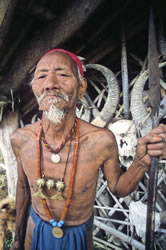 |
|
Fig. 46) Wancho warrior with
intricate chest tattooing |
Tattooing for Wancho men was a more serious
affair. As amongst other Naga groups, the
right to be tattooed was earned on the
battlefield and if a man or clan brought
back human trophies then the victors were
tattooed by the Queen. And account of 1872
stated that men who captured an enemy head
could receive the prestigious facial
markings (thun hu) of a warrior whereas men
who took only the hands or feet of their
victim would receive markings on the legs.
Of course, other authorities have stated
that "a tattoo mark on the face was an
indication of the fact that the man had
taken part in head-hunting and not
necessarily, as is the common belief, of his
having taken heads." I have also been told
that if a man had slain an enemy he may take
a chest tattoo and wear a brass ornament
around his neck that symbolized the number
of his human victims (Fig. 46). Or if he had
killed a dangerous animal like a tiger, he
may also earn the right to wear a facial or
chest tattoo.
Warriors typically received their tattoos
just days after a successful kill (e.g.,
three or five days after). Everyone knew who
deserved to be tattooed and the Queen
performed her work in her own house.
Sometimes it took her a fortnight to
complete all of the tattoos of the
successful warriors in her midst. One writer
who lived in the Wancho district in the
1950s reported "at the first head taken [the
Queen] tattooed the chest; at the second she
did the throat; at the third, the face; and
at the fourth and subsequent heads she did
the arms, back, and belly. The order may not
always be the same, but it is probably that
the amount of tattooing does represent the
degree of prowess of a man or at least of a
man's family or morung [paan in Wancho].
Sometimes human figures are tattooed on the
chest, and such a man is regarded as very
formidable." After a man received his
tattoos, it has been told that the brave
warrior observed a ritual period of taboo (genna)
and confined himself in his home and
refrained from speaking with anyone for one
day.
Land of Eternal Ink
From the warrior tattoos of the Naga, to
the magical kolam markings and tattoos of
the Hindu pantheon, India's tattoo cultures
comprise an incredibly rich tribal mosaic of
visual artistry spanning thousands of miles
and thousands of years. Here vestiges of
indigenous tattooing practices still survive
in forms close to their original sources,
even though modernity and other influences
have set in motion a series of
transformations that may perhaps lead to the
demise of these ancient traditions forever.
As one member of the Dangs tribe of Gujarat
put it: "People have improved now, so they
don't get tattooed; those who are educated
say this is a bad practice." Of course, many
of my younger Naga informants continue to
tattoo, but these designs are not the
traditional designs of their ancestors; they
are tattoos taken from the West - pretty
girls, skulls, and personal names of
girlfriends tattooed onto forearms. The same
can be said of tattoo trends in Gujarat and
other regions of India where abstract
designs once related to the landscape or
caste insignias have largely been replaced
by Western motifs like radios, padlocks,
wristwatches, airplanes, and parasols.
Furthermore, the tradition of tattooing by
hand in South India and other regions, by
women for women with payments in grain or
other foodstuffs, has been largely replaced
by machined art made by men for men with all
transactions paid for in cash.
Whatever the outcome of these
developments, this once hidden frontier of
body art should continue to warrant our
attention because it exposes the various
ways indigenous peoples in India were
culturally integrated into their human,
ancestral, spiritual, and environmental
worlds through bodily ritual and social
symbolism. Revealing that tattooing was not
only a practice that defined local
perceptions of existence: but one that also
asserted and inscribed affiliation,
maturity, personhood, as well as cultural
pride and artistic ability itself.
Literature
Chowdury, J.N. (1992). Arunachal
Panorama. Itanagar: Directorate of Research.
Fischer, E. and H. Shah (1973). "Tatauieren
in Kutch." Ethnologische Zeitschrift Zurich
11: 105-129.
Fuchs, S. (1968). The Gond and Bhumia of
Eastern Mandla. Bombay: New Literature
Publishing House.
Ganguli. M. (1984). A Pilgrimage to the
Nagas. New Delhi: IBH Publishing.
Gell, A. (1998). Art and Agency. Oxford:
Clarendon Press.
Gupte, B.A. (1902). "Notes on Female Tattoo
Designs in India." The Indian Antiquary 33:
293-297. July.
Iyer, D.B.L.K.A. (1935). The Mysore Tribes
and Castes. Vol. 1. Mysore: The Mysore
University.
Laukien, M. (2005). "Tattooing in India -
The Continent of Body Art." Skin and Ink
Magazine (6) 58-76. June.
Layard, J. (1937). "Labyrinth Ritual in
South India: Threshold and Tattoo Designs."
Folklore 48: 115-182.
Leuva, K.K. (1963). The Asur: A Study of
Primitive Iron-Smelters. New Delhi:
Bharatiya Adimjati Sevak Sangh.
Mills, J.P. (1926). The Ao Nagas. London:
MacMillan & Co.
Rao, C.H. (1946). "Note on Tattooing in
India and Burma." Anthropos 37: 175-179.
Rose, H.A. (1902). "Note on Female Tattooing
in the Panjab." The Indian Antiquary 33:
297-298. July.
Roy S.C. and R.C. Roy (1937). The Khāriās.
Ranchi: "Man In India" Office.
Rubin, A. (1988). "Tattoo Trends in
Gujarat." Pp. 141-153 in Marks of
Civilization (A. Rubin, ed.). Los Angeles:
UCLA Museum of Cultural History.
Russell, R.V. and R.B.H. Lāl (1916). The
Tribes and Castes of the Central Provinces
of India. Vol. III. London: MacMillan and
Co.
Thurston, E. (1898). "Note on Tattooing."
Madras Government Museum Bulletin 2(2)
115-119.
____(1906). Ethnographic Notes in Southern
India. Madras: Government Press.
Trivedi, H.R. (1952). "The Mers of
Saurashtra: A Study of Their Tattoo Marks."
Maharaja Sayajirao University Journal 1(2):
121-131.
Verrier, E. (1939) The Baiga. London: John
Murray.
___(1991). The Muria and Their Ghotul.
Bombay: Oxford University Press.
Back to Starting Page
|
1
|
2
|
3
|
4
|
5
|








